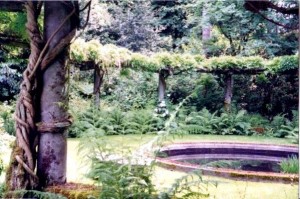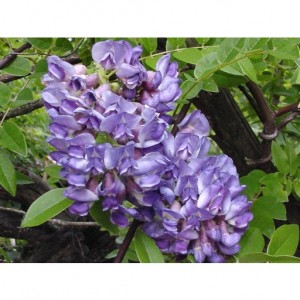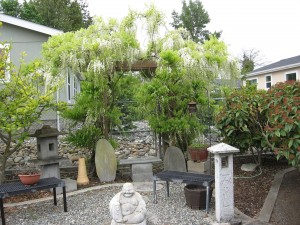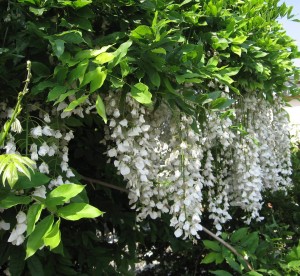Hardy to about O’F they are forgiving of soils and tolerate poor gardeners.
Wisteria floribunda or “japonica.” This Japanese Wisteria has bright green, larger leaves yet more narrow leaflets and the flower racemes can be much longer but relatively narrow. The flowers can sometimes reach two feet or more in length. ‘Alba’ has pure white blossoms; ‘Issei – or Issai Perfect’ combines bright white blooms to lavender*; ‘Longissima’ has violet blossoms marked with white and yellow in long clusters; ‘Rosea’ has pale rose – pink flowers and is quite fragrant; ‘Royal Purple’ is reputed to be one on the darkest purple-flowered of all wisterias;‘Texas Purple’ is another nice dark form; ‘Lawrence’ is a topnotch pale blue selection that is sweetly scented, but has smaller flowers. ‘Multijuga’ is equally scented with very long racemes of skinny and uninspiring blue-lavender flowers. Remember that not all will have a pleasing and elegant fragrance. I suspect that the named cultivar ‘Issai Perfect’ has been a further cultivar refinement and may actually be a hybrid involving W. sinensis.Wisteria floribunda ‘Violacea plena’ is an old double flowered form that goes back to the 1870. I used to sell this form in Santa Cruz, CA but I am not sure how available it is at the moment.
Wisteria sinensis . Chinese Wisteria. Perhaps the most common of the cultivars. This plant may be double blooming, once in spring and again in fall. The leaves have fewer and broader leaflets than W. floribunda and the flower clusters are shorter and broader, the blossoms open nearly at once. W.’Caroline’ is an outstanding cultivar (perhaps hybrid) from New Zealand and is a heavy bloomer with blossoms of deep lavender and white.
Wisteria venusta ‘Alba; Silky Wisteria is much harder to obtain, but as a bonsai possibility it might be the preferred species. This species is marked by down stems and foliage, broad leaflets and exceptionally large white flowers carried in relatively short, fat clusters.There will be a few other species that may surprise you as well.
Wisteria macrostachys ‘Clara Mach’ is another species that I used to grow and its origin is also North America. Not quite as hardy as the Asian species it has pendulous racemes of white flowers in mid – spring. Both this and the next one are lovely and the temperature hardiness is minimal.
Another interesting identifier being how the vines twin to the trellis or support. Chinese wisteria (W. sinensis) twines counterclockwise while the Japanese variety (W. floribunda) is the opposite, twining clockwise. This is important to know for when training wisteria vines, select an upright stem and attach it to the chosen support. Remove any side shoots and continue to train the main vine upwards in the direction it wants to go. Training it the wrong way will affect the growth although it will eventually be telling you its own preference.
Attributes: Easy to grow. Yes. Can they become a “weed” in the landscape architecture? YES. As with ivy, they can grow up a supporting tree to 100 ft. and their seedpods can become a menace to the neighborhood. Wisteria is an extremely hardy plant that is considered an invasive species in many parts of N. America, especially the Southeast, due to its ability to overtake and choke out other native plant species.
The mature plant Wisteria floribunda, (shown above) despite Nursery descriptions can be a pain and a lot of work. “Harmonious’ to others is not exactly true. The mature vines can be HUGE! I pruned one majestic source in the ‘Highlands’ (Seattle area) that had been developed by Olmstead. These vines had trunks the size of my thighs. Most Wisteria need two or three pruning’s a year.
Negatives and Positives:
Further summer pruning is the same, shortening to 5-8 growth buds. In late fall or winter one prunes the plant more seriously, generally reducing the growth to five or eight buds. One endeavors to create flowering spurs and it is courtesy to your neighbors to deadhead the flowers before they become seedpods.
HARD November or December pruning is needed, leaving just three to five (fat) flower buds to provide for spring flowers. At the same time one needs to reduce dead wood and thin out weak crowded branches. Base suckers should always be removed from the base at any time of the year.
Patience is required for bloom. I suggest a five-year allowance of patience at least. One customer I had threatened to delete the plants just after just three years of non-performance. Not a wise move. The (fourth) year it bloomed and is having a secondary fall bloom, just because I talked NICE to it. Threatening plants with uprooting is never he way to go.
POT AND SOIL for container growing.
For bonsai or container gardening a deep round pot glazed as to the color of the bloom would be nice, or in my own case I used a deep blue pot for a white colored cultivar. Good drainage is a must and over fertilization with Nitrogen should be avoided. Summer stress is often recommended to encourage flower buds.
To wrap up, all wisterias grow best in sheltered, warm and sunny positions and require moderately fertile and moist soils. ALL Require a strong support. Apply a slow-release balanced fertilizer and a mulch of well-rotted garden compost around the base of the plant in early spring. I must also note that in putting in these links, I found many Nurseries saying they take part shade. NO! They need full sun to bloom well.
(C) Herbert Senft 2009 edited 2014




